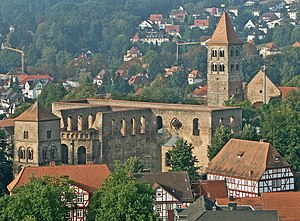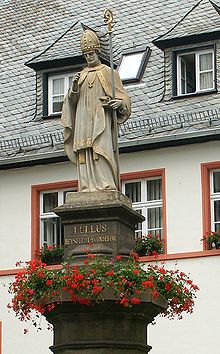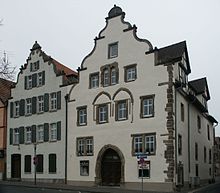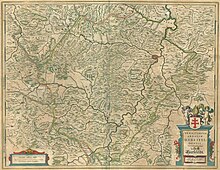Hersfeld Abbey
The Hersfeld Imperial Abbey, also Hersfeld Monastery or Hersfeld Monastery , existed from 769 to 1606 and had 66 abbots in these 837 years . The Benedictine - Abbey lay in the north Hessian town (Bad) Hersfeld . The core of monastery life was the collegiate church , which today only exists as the largest Romanesque church ruin in Europe. The history of the abbey is closely linked to the history of the city of Bad Hersfeld .
Foundation and early Middle Ages
In 769, the Mainz bishop Lullus founded a Benedictine monastery in Hersfeld on the site of a hermitage that the monk and later founding abbot of the Fulda monastery , Sturmius, had established there at an unknown time before Fulda was founded in 744. In place of Sturmius' chapel, Lullus built a church. The monastery and church were dedicated to Saints Simon the Zealot and Jude Thaddeus .
Lull founded the monastery after the monastery of Fulda , founded by Sturmius 744, not in the Archdiocese of Mainz could integrate (Trutzfulda). With this monastery founding he corresponded to the plans of King Karl (later Emperor Charlemagne ). Both operated from Hersfeld to subjugate and Christianize the Thuringians and the Saxons . The Hersfeld monastery thus became a mission center that received a lot of power and influence from the emperor.
From 769 to 786 Lullus was bishop (from 782 archbishop) of Mainz and abbot of Hersfeld. In 775 Charlemagne raised the monastery to abbatia regalis, the imperial abbey, and donated donations to it. In the 8th and 9th centuries, donations followed throughout the empire, which increased the power and influence of the monastery. In Thuringia , in particular, there were large property complexes. In 780 Lullus had the bones of St. Wigbert transferred from Fritzlar to Hersfeld, and the monastery thus became a place of pilgrimage . In 782 there were already 150 monks living in the monastery .
On October 16, 786, Lullus was buried next to his companion, Bishop Witta von Büraburg, in his monastery church in Hersfeld. The inventory of the Breviarium Sancti Lulli contains the property of the abbey at the time of Lullus.
The foundations of the chapel of Sturmius and the Lullus Church were found during excavations in the 20th century under the south wing of the transept of the monastery ruins. The burial niche of Bishop Witta was also found. Lullus' tomb was not found.
Abbot Bun (820-840) ordered a new church to be built in place of the so-called Lullus Church, which was consecrated to the apostles Simon and Jude. In 850, under Abbot Brunwart II (840-875), this Carolingian church , dedicated to the memory of Wigbert , was consecrated with a Salvator patronage and the bones of Lullus were transferred to the Bun Church by Archbishop of Mainz, Hrabanus Maurus , who also wrote the altarpieces had written. Since then the Lullus Festival has been celebrated. The monastery school has had a high reputation since the time of Abbot Bun . The headmaster at that time was Haimo , who later became Bishop of Halberstadt . It is believed that the unknown poet of the " Heliand " (an old Saxon epic of the 9th century, which Jesus as Duke and his followers in the world of the time) received his theological training in Hersfeld.
During the term of office of Abbot Druogo (875-892), the first known Hersfeld tithe index of the imperial abbey was written from 881 onwards . Another list of tithes was completed no later than 899 during the term of office of Abbot Harderat.
Under Abbot Diethart I (912–927), stone fortifications were built around the monastery in 925 to protect against the Hungarian invasions . A gate from this time was the south gate, it was probably closed in the Middle Ages as part of the city fortifications. During the excavations by the State Office for Monument Preservation between 1979 and 1981, the gate was uncovered and has since been open to pedestrians again. A 9th century salt works was also found near the gate . It can therefore be assumed that the monks had their own workshops within the monastery.
The palace buildings also date from the late 9th century and the beginning 10th century . A 60 m long stone building east of the collegiate church, the foundation walls of which were found in 1976 during the construction of the “Hospital Bad Hersfeld” nursing home, is interpreted as an auditorium of the Palatinate. The associated Pfalzburg (or Fliehburg) is assumed to be under the market square (formerly called flatness), north of the auditorium. This assumption is also borne out by the unusual size of the square, which is atypical in the region.
Abbot Megingoz (932–935), after whom the village Mengshausen (now part of Niederaula ) is named, had the Wachsenburg built to protect the Thuringian property of the monastery. The castle is one of the " three of a kind ".
High Middle Ages - The wedding of the abbey
Abbot Egilolf (963–970) achieved with a papal decree 966 that the abbey was directly subordinate to the papal chair. This was done through the direct cooperation of Emperor Otto I , whose friend and advisor was Egilolf. The abbey was no longer dependent on the Mainz diocese . The monastery library was founded under Abbot Gotzbert (970–985), and Abbot Bernhard (985–1005) founded a Benedictine provosty on Petersberg in 1003 , which was consecrated to St. Peter .
While Abbot Bernhard was still in office, on May 30, 1003 , King Heinrich II granted the abbey the ban on wild animals in the Reichsforst Eherinevirst ( Knüllgebirge and Seulingswald ). Thus, the abbey was awarded a closed area around Hersfeld, which also established the territorial connection with the Thuringian possessions of the abbey. This donation also included the division of the Eherinevirst (in today's Seulingswald) between the Hersfeld and Fulda Abbeys . The border ran along the Herfa to Wölf (today part of Eiterfeld ), from there to Eitra and Haune , then via Odensachsen, Rhina (now parts of Haunetal ) and Mengshausen to the confluence of the auditorium with the Fulda. This now represented the southern border of Hersfeld Abbey, and this has changed little over the centuries. (In this area it was also the southern border of the old district of Hersfeld and is still the southern border of the district of Hersfeld-Rotenburg today .)
The abbots Gotzbert and Bernhard let the harsh Benedictine monastery rules deteriorate. They lived like canons in their own houses and with private assets. As a result, the later Emperor Heinrich II, disregarding the free election of abbot in 1005, appointed Godehard as abbot. He came from Niederaltaich Monastery and remained as abbot in Hersfeld until 1012. Godehard reformed monastic life, reinstated the rules of Benedict , and gave the monks the choice of following the rules or leaving the monastery. 50 monks left. Godehard's successor was Abbot Arnold (1012-1031), who also came from Niederaltaich Monastery. He founded a Benedictine provostry, which he built on the Johannesberg from 1012 to 1024 and consecrated St. John ( Apostle John and Evangelist John ). Ruins of the monastery church and the brothers' house (dormitory) can still be seen today, and there are apartments in the former office building. During Arnold's tenure, the monastery received further donations from Emperor Heinrich II in 1015 and 1016, including the Memleben monastery , which further increased the economic basis and importance of the abbey.

In 1038 a fire destroyed the collegiate church. Abbot Meginher (1036–1059) immediately initiated the reconstruction. The choir and crypt were consecrated to St. Wigbert as early as 1040 . The abbot gave Emperor Heinrich III. the previous Hersfeld main relics of the apostles Simon the Zealot and Judas Thaddäus for the foundation of a collegiate church in Goslar . The Krodo altar there (a reliquary altar) probably also comes from Hersfeld. The oldest monastery seal showing St. Wigbert also dates from the time of Abbot Meginher.
The oldest dated bell in Germany today, the Lullus bell in the Katharinenturm, was cast by Abbot Meginher in 1038. It only rings on October 16 at 12:00, the anniversary of Lullus ' death , and on major public holidays. The first coins were also struck under Abbot Meginher. The former mint is still on the market square today. St. Wigbert was depicted on the two-sided pennies. In 1058 the monk Lambert entered the monastery. As Lampert von Hersfeld, he became a famous chronicler of his time. Presumably he was head of the Hersfeld monastery school under Abbots Ruthardt and Hartwig. He is also likely to have written Vita Lulli , the biography of Lullus, between 1063 and 1073 .
Between 1073 and 1074 King Heinrich IV gathered an army near Bebra-Breitenbach to put down an uprising by the Saxons and Thuringians. During this time his first son Konrad was born on February 12, 1074 in the Hersfeld monastery. His gilded cradle is said to have hung in an arch of the transept for a long time.
The disputes between the emperor and the Thuringians shook Hersfeld's position in Thuringia. To restore this, Abbot Friedrich (1091–1100) stayed mainly on the Wachsenburg (near Arnstadt ), where he also died. The Katharinenturm, a bell tower with a small chapel on the ground floor, was built under Abbot Adelmann (1114–1127). It still stands today at the entrance to the monastery district, on the side facing the city. The Lullus bell is documented in the tower at this time.
Under Abbot Heinrich I von Bingarten (1127–1155) the abbey was at the height of its history. King Conrad III. was often in Hersfeld. Conrad III. In 1139 he gathered his army near Hersfeld, which moved against Duke Heinrich the Proud of Saxony. Abbot Heinrich was also abbot of the monastery in Fulda for a short time .
The new Romanesque collegiate church was consecrated in 1144. The present King Konrad III. On this occasion, gave the monastery a tenth of wine from the imperial estates in Ingelheim am Rhein . Gertrud von Sulzbach , wife of Konrad III, died in Hersfeld in 1146 . Around 1150, new cloister buildings were added to the collegiate church in the cloister courtyard. The total construction time after the fire thus extended to about 112 years.
Abbot Siegfried (1180–1200) quarreled with Landgrave Ludwig III. from Thuringia via Vogteirechte . Siegfried, however, had at the court of Emperor Friedrich Barbarossa and Heinrich VI. high reputation and was able to influence their politics. He accompanied Barbarossa to Italy and negotiated with the Pope on behalf of the emperor. With Siegfried, the imperial abbey reached the climax of its imperial political importance, and Siegfried knew how to enforce the rights of the abbey against the landgraves of Thuringia.
Through several decrees (1220, 1231 and 1232) from Emperor Friedrich II , the abbey received sovereign rights under Abbot Ludwig I. The abbot was head of the state and was the prince abbot of the clerical principality of Hersfeld.
In 1239 Abbot Ludwig I founded the hospital at Johannestor for the poor, the elderly and the sick.
With the Franciscan monastery , a second monastery was built in Hersfeld. It was first mentioned in a document in 1269 at Neumarkt 33 and was probably abandoned again in the late 15th century. The successor to the Konrad-Duden-Schule stands in its place today. In the central building, essential masonry parts of the monastery are said to have been used, and in the basement there are still two vaults of the monastery. The foundations of the monastery church are presumed to be under today's playground.
Late Middle Ages and Reformation
After the end of the Staufer dynasty in the 13th century, the power of the kings decreased, and the Hersfeld Imperial Abbey, which traditionally relied on the kings and emperors of the Holy Roman Empire , was now without this power-political support. The up-and-coming landed gentry and the burgeoning bourgeoisie in the city did the rest, so that the following centuries of the abbey were characterized by constant attempts to obtain property rights and rights of rule.
First, however, Abbot Ludwig II of Mansbach (1324-1343) began in 1328 with the construction of the castle to the oaks in the Fuldaaue. But already his successor, Abbot Johann II. Von Elben (1343-1367), had to sell a lot of herfeld property due to ongoing financial problems. Among other things, he sold the hospital to the city. At that time, however, the abbey was still supported by the king; so in 1347 Charles IV allowed the abbot to keep Jews for his own benefit of the imperial fief (the so-called Judenregal ).
In 1372, under Abbot Berthold II von Völkershausen (1367-1387), the fortified moated castle on the oaks was completed, and in 1378 the first organ was installed in the collegiate church. Abbot Berthold faced the growing influence of the Landgraviates of Thuringia and Hesse on his principality when the city of Hersfeld concluded a protective alliance with the Landgrave of Hesse on January 28, 1373 . The abbot then sided with Kurmainz , who had long been in a bitter dispute with the landgraves for supremacy in Hesse. Abbot Berthold subsequently allied himself with the Sternerbund , an alliance of counts and knights directed against the landgrave, and tried on Vitalisnacht 1378 to restore his supremacy in the city with the help of the Sterner. This failed, however, and the Principality of Hersfeld was forced to conclude a protective alliance with the Landgraves of Hesse in 1383.
However, further disputes with Hessen followed. Landgrave Ludwig I , for example, built Ludwigseck Castle in Hersfeld in 1416 (it was part of the Wildbann district, which the abbey was assigned by Emperor Heinrich II in 1003). Abbot Hermann II of Altenburg (1398–1418) had his hands tied, and he could only resignedly state that the landgrave had built this castle "on our stiffts ground and property". These disputes subsequently strengthened the influence of the Archdiocese of Mainz, which was established under Archbishop Adolf I from 1385 and again under Archbishop Conrad III. from 1420 patron of the abbey and mediator between Hersfeld and Hessen. In the Mainz-Hessian War in 1427, however, Landgrave Ludwig finally triumphed over Kurmainz, and the city of Hersfeld renewed its alliance with the Landgrave. Thus the abbey stood against Hessen without allies. In order to secure the existence of the abbey, Abbot Albrecht von Buchenau appointed the landgrave hereditary patron of the monastery in 1432. This inheritance protection treaty was renewed in 1458 and 1490. The principality thus de facto belonged to Hesse from 1432, but remained formally as an imperial fiefdom imperial principality.
In order to secure the areas still remaining to the abbey against the landgraves, and because of considerable financial problems, the abbot tried in 1513 to unite the abbey with that of Fulda in the so-called "Hersfeld affair" . In the run-up, the abbey lost a trial at the Reich Chamber of Commerce against the city, which the abbey continued to blame. In this situation, Abbot Volpert Riedesel zu Bellersheim (1493–1513) resigned in favor of Abbot Hartmann, the Abbot of Fulda. In return, the abbot von Hersfeld took over the Fulda provost of Andreasberg. The Hersfeld Chapter agreed to this association with the Chancellor of Fulda, Philipp von Schweinsberg. On September 10, 1513, Abbot Hartmann announced the annexation of the imperial abbey in Eichhof Palace . Only Kraft Myle , who later became Abbot Crato I, opposed this approach. This also applied to the city, which, supported by the Hessian Countess Anna von Mecklenburg (her son was the abbey guardian), refused to obey Abbot Hartmann. Anna succeeded in getting Ludwig von Hanstein, abbot of the Helmarshausen monastery , to be elected administrator of the abbey. On September 15, 1515 he was elected counter-abbot by the Herfeld convent ; the Hessian Chancellor Johann Feige chaired it. This situation was not sustainable for Fulda Abbey for long, so Abbot Hartmann renounced Hersfeld Abbey in 1516.
His successor, Abbot Crato I. (1516-1556), the first civil abbot of Hersfeld, renewed in 1517 along with Dean and convent to Erbschutzvertrag with the Landgrave Philip I. It was the abbey forbidden to join another abbey, and stipulates that future abbots needed the approval of the House of Hesse. At the invitation of the abbot, Luther preached in the collegiate church in 1523; this is how the Reformation began in Hersfeld. Two years later, many from the abbey’s sphere of influence belonged to the Protestant faith when the abbey district was sacked in the Peasants' War in 1525 . Landgrave Philipp came to the aid of the distressed abbot and put down the uprising. The landgrave used this to his advantage and took large parts of the imperial abbey to cover his costs; for example Berka and the Landecker Amt (the office essentially comprised the area of today's municipality of Schenklengsfeld ). Through contracts in 1550 and 1558 with Abbot Crato and his successor Abbot Michael (1556–1571), the Landgrave also took half of Hersfeld; so the monastery came under the direct influence of the Landgraviate of Hesse.
The religious and political conditions of the abbey became so complicated by these events that it became more and more difficult to find an abbot who could do justice to the various interests. Already during the term of office of Abbot Crato I, the situation within the abbey was such that the abbot was Catholic, the dean Protestant and the chapter mixed, while the population had become largely Protestant. In addition, the patrons of the Catholic abbot, the Hessian landgraves, were zealous defenders of Protestantism . This situation existed without the permission of the emperor and contradicted church laws and the will of the pope . Thus, a Catholic abbot had the task of serving the Lutheran landgrave without annoying the pope and emperor. In addition, the situation in the run-up to the Thirty Years War became more complicated as the differences between the denominations intensified.
Nevertheless, Abbot Michael founded a monastery school in the buildings of the former Franciscan monastery in 1570. Ludwig Landau , the previous coadjutor of Abbot Michael, was his successor as Abbot Ludwig V (1571–1588). During his term of office he fought with Electorate Saxony about suzerainty in Thuringian districts and promised Landgrave Wilhelm IV of Hessen-Kassel the future administration in Hersfeld. His term of office was marked by one last building boom. The abbey district, the municipal abbot's residence and Eichhof Palace were rebuilt in the Renaissance style.
The penultimate abbot, Kraft Weiffenbach (1588–1592), was no longer recognized by the Pope, and the only Catholic in the chapter, Joachim Röll , refused to recognize him. Landgrave Moritz von Hessen-Kassel installed his personal friend, the last abbot Joachim (Joachim Röll) (1592–1606) in his office in 1592. He was the last Catholic in the monastery, and the few remaining monks were Protestant. In 1604, Abbot Röll made the eldest son of Landgrave Moritz, Hereditary Prince Otto of Hesse (* December 24, 1594, † August 7, 1617), coadjutor of the monastery and thus his successor. The abbot died on February 24, 1606, and the 12-year-old Otto von Hessen took over the administration of the abbey as administrator on March 4, 1606, becoming the first secular ruler in Hersfeld. An attempt by Pope Clement VIII to have a Catholic successor installed by Abbot Balthasar von Dernbach after Abbot Joachim's death was thwarted by his death. Otto died in Hersfeld in 1617 under unexplained circumstances. Otto's brother, who would later become Landgrave Wilhelm V , was appointed as his coadjutor for the Hersfeld Abbey as early as 1612, and he succeeded him after Otto's death. Emperor Matthias' objection was dealt with dilatorily and ultimately ignored.
During the Thirty Years War , imperial troops under Count Tilly occupied the city in 1623. Tilly established his headquarters in Hersfeld until 1625. The abbey was again occupied by Benedictine monks, and monks also returned to the former Franciscan monastery. Emperor Ferdinand II entrusted his son Leopold Wilhelm of Austria with the office of Commendatar abbot of the imperial abbey with the aim of recatholicization . In 1629 the Fulda abbot Johann Bernhard Schenk zu Schweinsberg was appointed administrator of the monastery. Landgrave Wilhelm V. Hersfeld recaptured in 1631. But since he the Peace of Prague declined in 1635, the emperor imposed on him the imperial ban and denied him and his successor William VI. continue to own Hersfeld.
Principality of Hersfeld
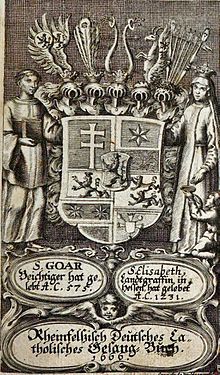
After the Thirty Years War , the abbey became a secular principality and was taken over by Emperor Ferdinand III. Awarded by Habsburg to the House of Hesse-Kassel in 1648 as an imperial fief. The Peace of Westphalia in Munster and Osnabrück regulated this in Article 15, § 2. Since then, the Landgraves of Hesse-Kassel also had a seat and vote in the Reichstag as Prince von Hersfeld .
In 1649 Landgrave Ernst von Hessen-Rheinfels-Rotenburg , son from the second marriage of the former Landgrave Moritz von Hessen-Kassel, made Rheinfels Castle his residence. In 1652 he converted to the Catholic Church, then apparently felt the possession of the former spiritual rule of Hersfeld, which had now fallen to him, as a burden of conscience and had a corresponding inscription placed in his castle chapel. The Jesuit and Bollandist Daniel Papebroch wrote about this in his travel memories in 1660:
“A chapel with a gilded ceiling is very nice at the castle ... Under the singing gallery you can see the coat of arms of the Landgrave with the following inscription: 'Ernst, the first of his line to return to the Catholic Church, full of burning hope that many like him follow'. Then you saw his individual coats of arms, piece by piece, each with its motto underneath. The most notable verses were under a red double cross, which is the coat of arms of the abbey that fell to the landgrave in the Peace of Westphalia; they read: 'I involuntarily add this coat of arms to my coat of arms; for what is yours should be given to you, crucified Jesus. "
The monastery was abandoned under Abbot Joachim Roell, and the collegiate church has only been used for Protestant services since the Peasants' War . In the wake of Tilly , during the Thirty Years' War , monks moved in again for a short time. However, there was no longer a regular monastery operation. During the Seven Years' War , the collegiate church used as a granary was set on fire by withdrawing French troops on February 19, 1761; since then it has been regarded as the " monastery ruins ".
Provosts and priories
This list gives an overview of the priests and priests of the abbey. In addition, there were numerous patronage churches and incorporated churches, most of which, like the monasteries and provosts mentioned here, were in Hesse or Thuringia. But there are also some churches in the Moselle area and the Rhineland.
Provosts
- Benedictine provostry Johannesberg near Hersfeld (founded around 1024)
- Benedictine provostry Sankt Peter on the Hersfelder Petersberg (founded around 1000)
- Benedictine monastery Sankt Maria im Memleben (since 1015 provost of Hersfeld, founded in the 10th century)
Priories
- Benedictine convent Sankt Walburgis in Arnstadt
- Augustinian Choir Monastery Sankt Maria in Frauenbreitungen (founded around 1150)
- Benedictine monastery of Sankt Maria in Herrenbreitungen (founded in the 11th century and hermit since the 12th century)
- Benedictine monastery of Sankt Maria in Cornberg (founded in the 13th century)
- Cistercian convent of St. Maria in Frauensee (founded around 1200)
- Benedictine monastery Sankt Wigbert in Göllingen (founded in the 10th century)
- Cistercian convent of St. Maria on the Kreuzberg near Hersfeld (founded in 1191)
- Franciscan monastery Sankt Elisabeth in Hersfeld (verifiable since 1269)
- Nunnery of St. Mary and John in Aua (moved to Blankenheim in 1229 , founded in 1190)
- Canon Monastery of Saint Peter in Ohrdruf (founded in the 8th century)
- Cistercian or Benedictine convent of St. Maria and Johannes Baptist in Kreuzberg (founded in the 13th century)
Bailiff
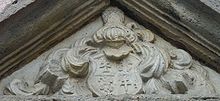
Since the founding of the abbey, it needed secular persons to represent the abbey externally and to exercise secular jurisdiction. The bailiff ("advocatus") thus exercised an important office for the abbot, which was directly related to the property situation. According to Franconian law, the abbot required at least one bailiff for each district in which the abbey's free float was located. The first bailiffs named for the Hersfeld Abbey are "advocati sui Theotharii in pago Friesonoveld " and a "Erlolf in pago Languizza". They were mentioned in two documents from Heinrich I on June 1, 932.
Initially, this office was presumably given to free landowners, until it was occupied by members of the aristocratic class around the turn of the millennium. The first mentioned Vogt von Hersfeld in Hessengau was a "comes" Udo, mentioned in 1057. According to some sources, the bailiwick came to the Gisonen through marriage . A Count Giso, is notarized from 1099. It is assumed that Giso III. is meant. During this period, a system of upper and lower bailiffs also prevailed. The first documented sub-bailiff is "subadvocatus Heinricus", who was mentioned in 1095 and also in the 1099 document mentioned above.
At that time, but no later than 1110, the office was passed on by inheritance. In that year Ludwig I of Thuringia married the daughter of Giso IV , Hedwig . After Gisos IV's death, the Bailiwick passed from the Gisonen to Ludwig I and the Thuringian landgraves . From 1133 Ludwig I was named as Vogt von Hersfeld, in 1139 together with a subordinate. Ludwig I entrusted his brother Heinrich Raspe II with the administration of his Hessian possessions and bailiwick rights. Even Ludwig II. Was the Hersfelder bailiwick to his brother Heinrich Raspe III.
The abbot could no longer determine his secular representative himself, and the bailiffs were usually not restricted in their rights by contracts. This led to the fact that the property slowly changed hands. B. Melsungen and Rotenburg on the Fulda . Abbot Siegfried tried to counter this alienation of the property in the case of the Thuringian landgraves by, after the death of Heinrich Raspe III. in the year 1180 the bailiwick was declared to be finished. This led to a dispute between the abbot and Ludwig III. of Thuringia , which was settled in Erfurt by Emperor Friedrich I in 1182. After that, the abbot received back the bailiwick over large parts of the wild bans in the Reichsforst Eherinevirst, which Emperor Heinrich II had given to the abbey in 1003, but had to recognize the bailiwick of the Ludowingers in the other areas.
In the high court district around Hersfeld (presumably it included the monastery district with the daughter monasteries and the city) this led to the burgraves being deprived of the high level of jurisdiction. Instead, this passed from 1182 to the abbot's sergeant, the so-called " villicus ", who has since carried the title of mayor . On April 4, 1182, the abbot named "Beringerus scultetus" the city's first mayor.
List of the abbots of Hersfeld
literature
- Verena Smit: The building history of the Salic abbey church in Hersfeld (= studies on cultural heritage in Hesse 4), Regensburg 2018 [1]
- Louis Demme: News and documents for the Chronicle of Hersfeld. 3 volumes. Published by Hans Schmidt, Hersfeld 1891, 1893; Vol. 3 Verlag von A. Webert, Hersfeld 1900. (Volume 1 online)
- Friedhelm Juergensmeier , Franziskus Büll, Regina Elisabeth Schwerdtfeger: The Benedictine monastery and nunnery in Hesse. (= Germania Benedictina. Vol. 7: Hessen ). EOS-Verlag, St. Ottilien 2004, ISBN 3-8306-7199-7 , pp. 589-639.
- N. Landeck, M. Würz, HJ Hohmann: Bad Hersfeld. Eyes Pictures and stories. Ott-Verlag, Bad Hersfeld 2001, ISBN 3-9806842-2-9 .
- Wilhelm Neuhaus: From 12 centuries. Stories and pictures from Hersfeld's past. (= Hersfelder Heimatbücher. 2, ZDB -ID 1049131-4 ). Ott-Verlag, Bad Hersfeld 1935.
- Elisabeth Ziegler: The territory of the imperial abbey of Hersfeld from its beginnings to 1821. (= publications of the Institute for Historical Regional Studies of Hesse and Nassau. 7, ZDB -ID 506862-9 ). With an atlas. NG Elwert'sche Buchhandlung, Marburg 1939. (Also: Marburg, Univ., Phil. Diss.)
- Elisabeth Ziegler: With miter and crook - the abbots of the Reichskloster (the Reichsabtei) Hersfeld , in: Bad Hersfelder Jahresheft, Volume 16, Bad Hersfeld 1970, pp. 6–22
- Leo Bönhoff : The Hersfeld own in the Mark Meissen in: New archive for Saxon history and antiquity, Volume 44, 1923.
- Unprinted records: The bulk of the written records are now kept in the Hessian State Archives in Marburg .
Web links
- Literature on Hersfeld Abbey in the Hessian Bibliography
- Document from King Karl to the abbey, which became an imperial abbey
- Mein Heimatland , a magazine for history, folklore and local history as a monthly supplement in the Hersfelder Zeitung
- History of the Principality of Hersfeld with a map of Northern Hesse from 1789
- Elisabeth Ziegler, With miter and crook. The abbots of the imperial monastery (the imperial abbey) Hersfeld , in: Bad Hersfelder Jahresheft, Volume 16, Bad Hersfeld 1970, pp. 6–22
Coordinates: 50 ° 51 '58.6 " N , 9 ° 42' 9.5" E
Footnotes
- ↑ The years 736 and 743 were discussed above all. The early chronology of Boniface and his founding and students is extremely uncertain. The Sturmi chronology depends on a number of difficult and probably never conclusively clarified problems: the identification of his Fritzlar teacher Wigbert with Wigbert the Elder. Ä. or Wigbert d. J., the certainty of the late 746/747 year of death of the former as well as the related dating of Letter 40 from Bonifatius, in which a Styrme (= Sturmi) who is obviously not (yet) a priest and could be identical with Sturmi, is mentioned as master chef von Fritzlar, cf. St. Schipperges, Bonifatius ac socii eius. A socio-historical investigation of Winfrid-Bonifatius and his environment. Mainz 1996, note 282, p. 42 (dating letter 40); Pp. 142-146 (Sturmi); Pp. 161–164 (Wigbert the Elder and Wigbert the Younger), finally that of the existence and dating of the so-called Annales Bonifatiani antiquissimi, cf. Eckhard Freise: The beginnings of historiography in the Fulda monastery. Diss. Münster 1979. The decisive point in the Vita Sturmi is, apart from the problematic source value of a literary text for questions of chronology that was written more than two generations after the events, controversial in terms of textual criticism, cf. G. Becht-Jördens, Sturmi or Bonifatius. A conflict in the age of the Anian reform about identity and monastic self-image as reflected in the altar rituals of Hrabanus Maurus for the Salvator Basilica in Fulda. With appendices to the tradition and critical edition of the tituli as well as to text sources on the architecture and building history of the Salvator Basilica. In: Marc-Aeilko Aris, Susanna Bullido del Barrio (Edd.): Hrabanus Maurus in Fulda. With a Hrabanus Maurus bibliography (1979–2009) (Fuldaer Studien 13), Josef Knecht, Frankfurt am Main 2010, here note 8, p. 127 with further references; L. Boschen, The Annales Prumienses. Your immediate and further relatives. (Schwann) Düsseldorf 1972, p. 139 f. with note 221. The question is whether the dating of 736 given in the Hersfeld Annals refers to the short version of the Vita Sturmi, c. 11 with the reading nono iam tunc, ex quo eremo inhabitare coeperat anno ( instead of non ... anno , so the only manuscript with the original long version Würzburg, Universitätsbibl., M. p. Th. Q. 13) for the indication of the time Distance between the founding of the hermitage in Hersfeld and the departure of Sturmi to Fulda goes back or was handed down independently. On the Hersfeld Annals (mid-10th century!) Cf. Wilhelm Wattenbach, Robert Holzmann , Germany's historical sources in the Middle Ages. The time of the Saxons and Salians, part I The age of the Ottonian state (900-1050). New edition, arranged by Franz-Josef Schmale. Scientific Buchgesellsch., Darmstadt 1967, pp. 40-42.
- ↑ Ed. E. Dümmler. In: MGH Poetae. Vol. 2, Weidmann, Berlin 1884, pp. 228-230.
- ↑ MGH DD HII 321. Digitized .
- ↑ Hans Weirich: Document book of the Reichsabtei Hersfeld, Volume 19, Part 1, publications of the Historical Commission for Hesse and Waldeck, Verlag NG Elwert, 1936, pp. 95, 166.
- ↑ Digital scan from the source
- ↑ Elisabeth Ziegler, pp. 14-18.
- ↑ Per manum advocati sui Gisonis redonavit abbas Fridericus
- ↑ Et Lodewici regionarii comitis et advocati et Bobbonis subadvocati
- ↑ In 1156 Ludwig II. Of Hungary, together with the bailiff Bobbo of Reichenbach mentioned
- ↑ The forest included the center of the abbey (Hersfeld, Petersberg, Johannesberg, Rohrbach, Niederaula, Dankerode and the wheat slope of Bebra)
